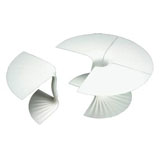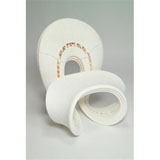Creative créche

A new digital manufacturing centre in London will allow practitioners to get experimental and gain access to some of the latest technology and software around – time to relive those heady student days and start playing, says Trish Lorenz
Ah, the heady days of student life – late nights, cheap beer and some of the best facilities and top end technology you’re ever likely to use. But when those halcyon days come to an end, so too does access to the amenities, which is a shame as often it’s only then that many graduates fully appreciate how useful technology was in developing and realising new concepts. And as time passes it’s easy to lose touch with on-going technological developments and the creative opportunities they offer.
Metropolitan Works, a digital manufacturing centre that is part of London Metropolitan University, addresses this imbalance. It is already home to more than £1m of equipment, with a further £1.5m to be spent on new technology over the next 12 months. Facilities available include rapid prototyping, laser cutting, 3D scanning, CNC routing and digital printing. Furniture and product designers, along with designer makers from London and further afield, can now access both the cutting edge digital technology and the expert tuition available, without the need to sign up for any further education.
Metropolitan Works director Guy Beggs says the organisation’s remit is to ‘open up digital manufacturing to the creative industries, and to give creative people time to experiment and play’. He is keen to stress that the emphasis at the centre is creative rather than technology-led. ‘It’s all about pushing boundaries and giving designers the support and intellectual framework to test ideas,’ he says. ‘We want creative people to explore and exploit these industrial techniques and push the limits of the materials and process.’
One machine, the laser cutter, has already seen designers experiment with materials ranging from silk to mother of pearl. ‘We don’t always know if the machine will be able to do it, but are always happy to try it out,’ says Beggs.
Creatives that have taken up the offer to date include architects, sculptors and even structural engineer Packman Lucas, who works with Prince Philip Prize-winner Thomas Heatherwick in realising his designs. And for the past 12 months the organisation has had two designers in residence – Tomoko Azumi and Assa Ashuach.
Azumi is in the early stages of her experimentation with the technology. Her Digital Technology and The Five Senses project juxtaposes human senses, such as touch and sight, with advanced technology. The result is a range of 3D objects and light installations comprising flat images, hand-cut and suspended paper, laser-cut sheet materials, hand-woven meshes and rapid prototype models. Her work has already extended the group’s knowledge of the software’s capabilities, says Beggs.
Ashuach is further advanced in his research and has worked with the equipment to develop a range of chairs and stools, in particular the Osteon chair. To create the range, he used selective laser sintering – a 3D rapid prototyping tool – and worked with software developer Dr Siavash Mahdavi of Complex Matters.
Combining software and technology has enabled Ashuach to create a skeleton within the chair that offers support to the exact degree required and only in those areas it is needed, optimising material use and enabling customisation and real experimentation with form. The result is a chair with an acrylic skin and an internal composition that resembles a biological structure and the mechanism of bone.
‘It’s a smart chair in that it’s not solid and doesn’t have a honeycomb structure. The [skeleton] is exactly sufficient for the support is needed,’ Ashuach explains. He is evangelic about the possibilities of the technology. ‘These tools could completely alter the future of product design by creating a whole new design process and work flow,’ he says. ‘But people need time to learn the software and master the tools to come up with new designs.’
For designers keen to experiment with technology and interested in pushing both the boundaries of their ideas and the accepted structure and form of objects, Metropolitan Works seems to offer that rare opportunity – playtime in a grown-up world.
Available technology at Metropolitan Works:
3D printing – a rapid prototyping process that enables designers to visualise ideas in full-colour plaster 3D models. The technology is an additive layering process and can be used to construct models with interior parts.
Selective laser sintering – a rapid prototyping and manufacturing process that uses a polyamide powder. This means the products it creates are very durable and the technology allows for snap fixings and movable parts. The material can be dyed post-production or decorative finishes can be applied.
Direct metal laser sintering – uses the same process as SLS, but uses metal powders including titanium, stainless steels and bronze.

Laser cutting – a low cost (£45 an hour) entry level technology. Can cut items ranging from paper, fabrics, plastics and timber up to 18mm in thickness. It reads vector files but can also scan and engrave images from grey scale raster files.
Digital textile printer – is able to print both reactive dyes for natural fabrics and sublimination dyes (using a heat transfer process that transfers the colour into the fabric rather than simply applying to the surface) for polyester-based synthetic fabrics.
3D scanning – both hand-held and desktop scanners are available. Hand-held devices are labour intensive, but enable users to scan larger objects and complex geometries.
Haptic device – a virtual carving or sculpting tool that allows designers to work in 3D modelling on the computer. The sculptured object can be felt and touched through the device as it is modelled.
-
Post a comment



